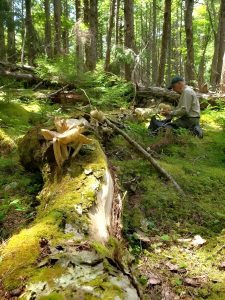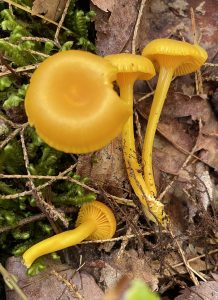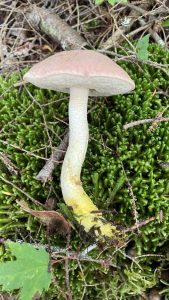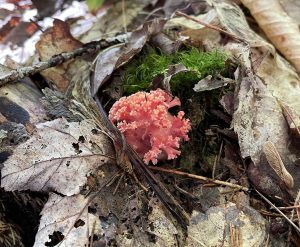
Keith Egger collecting mushrooms in an old deciduous forest in Kejimkujik National Park. On the rotting log in the foreground is Eastern American Platterful Mushroom (Megacollybia rodmanii) a common spring inhabitant of decomposing wood.
Click on images for larger versions.
The post is adapted from the text of a letter written by Keith Egger addressed to Nova Scotia Premier Tim Houston, Minister of Natural Resources Tory Rushton, and to Minister of Environment and Climate Change Tim Halman; it was sent on Aug 13, 2025. We had seen a copy of it and Keith graciously agreed to our posting it and providing some supplementary photos and info. about himself.
In the letter, Keith addresses the apprehension that many of us feel about the NS Government’s commitment to achieving 20% protection by 2030. For example, he comments that he had heard members of the NS government suggest that protecting areas that can’t be logged (e.g. steep hillsides and ravines, islands, wet forests) might be a path to reach protection and explains why that would not be an ecologically sensible strategy.
Keith is Professor Emeritus in the Department of Ecosystem Science & Management at the University of Northern British Columbia in Prince George, BC. He retired after 29 years studying microbial diversity and ecology and moved to Nova Scotia in 2019. He has been active since retirement studying mushroom diversity in Nova Scotia’s old-growth forests.
– NSFN
——–
Keith Egger to Premier Houston on Meeting your 20% by 2030 obligations
Bridgetown, NS
Aug 13, 2025
Mr. Premier,
I am a retired university professor. I spent the better part of my academic career studying and researching biodiversity. Biodiversity is in crisis and facing the multiple threats of habitat loss, habitat fragmentation and invasive species, all within the context of a progressively warming climate. Climate change is happening faster than many organisms can adapt, forcing them to disperse to habitats where they can survive. If those habitats aren’t available, or are too fragmented or too modified by invasive species, they will perish.
In recognition of the threats worldwide to biodiversity, nearly 200 countries have committed to the “30 x 30” initiative to protect 30% of Earth’s land and waters by 2030. In 2021 your government committed to protecting 20% of Nova Scotia’s lands and waters and legislated this benchmark in the Environmental Goals and Climate Change Reduction Act. In the Collaborative Protected Areas Strategy that was released in December 2023 to guide this initiative you pledged to act quickly to achieve this goal. Thus far your progress has been slow and confrontational rather than collaborative.
While climate change is putting unrelenting pressure on ecosystems, human priorities such as agriculture, forestry and development continue to contribute to habitat loss. Wetlands are lost to development; meadows and marshes are converted to agriculture; and native forests are logged and replaced with commercially valuable species. My research area related to forest systems, so I’ll limit further comment to that topic.

Shining Waxcap Gloioxanthomyces nitidus: Shining waxcap is a decomposer fungus that prefers wet, old forests.
In Nova Scotia, the native Wabanaki/Acadian forest has been harvested to the point that less than 1% of old-growth forest survives. These old forests punch above their weight in sequestering carbon and harbouring unique species assemblages. When this habitat is lost or degraded, disproportionate amounts of carbon are released and the unique species are forced to disperse, if they can. While your government’s initiative to protect what’s left of Nova Scotia’s old growth forest is a step in the right direction, the province has a long way to go to maintain and restore viable old forests and stem biodiversity loss.
I have heard members of your government suggest that protecting areas that can’t be logged (e.g. steep hillsides and ravines, islands, wet forests) might be a path to reach protection goals. Unfortunately, due to habitat fragmentation, this strategy would not adequately protect biodiversity. Isolated patches of habitat make dispersal more difficult and are often too small to sustain the unique species assemblages that maintain ecosystem function. This issue is compounded by edge effects. Edges of habitats differ from contiguous areas in having differences in light, humidity, air movement, and soil characteristics among others. Organisms adapted to contiguous habitats often can’t survive or thrive at the edges, particularly when competing with opportunistic and invasive species. This has been shown for organisms as diverse as invertebrates, lichens, plants and birds. Since small patches are dominated by edges, this reduces their effective size. Small, fragmented habitats within a mosaic of harvested forest will do little to stem biodiversity loss, particularly if harvested areas are altered to favour commercially valuable species rather than the original native forest. To seriously address biodiversity loss and maintain ecosystem function requires large contiguous areas of natural habitat.

Chrome-footed Bolete (Harrya chromipes). It is named for the bright yellow colour at the base of the stem. It is common in old-growth Eastern hemlock stands where it forms mycorrhizas with a variety of tree species.
This is exactly what citizen groups have proposed with community-led initiatives to protect areas such as the Chain Lakes, Ingram River, Goldsmith Lake, and Beal’s Brook Wilderness areas. These sites have proven biodiversity values, as evidenced by the exhaustive work of citizen scientists. They contain a mix of native old-growth, old-growth candidate, and mature forest stands. This provides the best opportunity to maintain biodiversity and old-growth associated species at risk. The solution proposed by some forestry advocates, with isolated and fragmented native forest stands embedded in a mosaic of harvested forest, will not be effective in maintaining biodiversity.
Rather than follow the spirit of your Collaborative Protected Areas Strategy and working with community groups to develop an effective protected areas strategy, your government has been needlessly confrontational by targeting High Production Forestry to the very areas that community groups have championed for protection. Instead of viewing motivated community groups as allies, you have targeted them with dog-whistles – “special interests” – and cut them out of the process, which seems to be dominated by DNRR and industrial forestry interests. The Minister of the Environment, a co-sponsor of the Collaborative Protected Areas Strategy, is nowhere to be seen.

Red Coral (Ramaria araiospora), an inhabitant of old mixedwood forests. Although not much is known about its ecology, it likely forms mycorrhizas with forest trees.
We hear much from your government about the need to act forcefully in the face of Trump’s tariffs and little about caring for our environment. This creates public apprehension that you intend to abandon your commitment to 20% by 2030 much as you abandoned the Coastal Protection Act. Your government argues that now is the time for resource exploitation not protection but that is leading us down the path to ecosystem disfunction. Mr. Trump’s impact will be measured in years to decades. Allowing the degradation of biodiverse ecosystems and impairing their ability to adapt to climate change will be measured in centuries to millennia. Future generations will pay the price.
Mr. Premier, I implore you to partner with concerned Nova Scotians to fulfil your commitment to protect 20% of Nova Scotia’s lands and waters as a buffer against climate change and biodiversity loss. To be effective, this must include large contiguous areas such as the community-proposed protected areas, with a moratorium on logging until they can be evaluated. Future generations deserve no less.
– Keith Egger
Professor Emeritus,
University of Northern British Columbia

